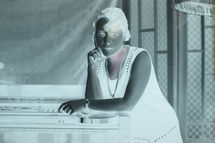Search


Portraits of the Portuguese Republican Conspiracy: Three Negatives from Foto-Carvalho
Three large-format negatives from Foto-Carvalho, a former Estremoz studio, reveal the faces of Machado Santos, Luz de Almeida and António Maria da Silva, members of the Carbonária’s Alta Venda. Found broken and unidentified, these portraits link the local history of Estremoz to the republican conspiracy that led to the 1910 Revolution. Preserving also means discovering and sharing the hidden stories of photographic archives.


Retouched Collections – Foto-Estefânia: Retouching, Neighborhood Photography and the Glamour of Cinema
A technical and cultural analysis of the Foto-Estefânia collection, a set of retouched negatives from 1920s–30s Lisbon. The article explores how cinematic glamour shaped studio portrait aesthetics and the manual gestures applied to the negatives. A rigorous approach to image, taste, and photographic heritage.


Retouched collections – Foto-Carvalho – Portrait, a Retoucher and Local Identity
Exploring the history of the Foto-Carvalho studio (Estremoz) and the invisible role of retoucher D. Esmeralda. Through the negatives, we uncover the technical gestures that shaped photographic images and local identity in early 20th-century Portugal.


Looking Deeper: Stereoscopic Photography at the Turn of the 20th Century
Celebrating Stereoscopy Day, June 21th. Explore the history and experience of stereoscopic photography at the turn of the 20th century, through cameras, viewers, and images from my collection. A look into the fascination with depth and the persistence of visual wonder.


Retouched collections – Seeing the Invisible
A proposal for a new reading of photographic negatives as cultural objects. Based on six Portuguese collections, it explores the role of manual retouching in image-making, highlighting the material, technical, and symbolic value of negatives in studio, scientific, and amateur photography of the 20th century.


Archived Negatives: Preserving the Invisible
On International Archives Day, we reflect on photographic negatives as cultural, technical, and historical objects. Retouching — often invisible but essential — reveals gestures and intentions worth preserving. Archiving also means interpreting, and making visible what so often remains hidden.









